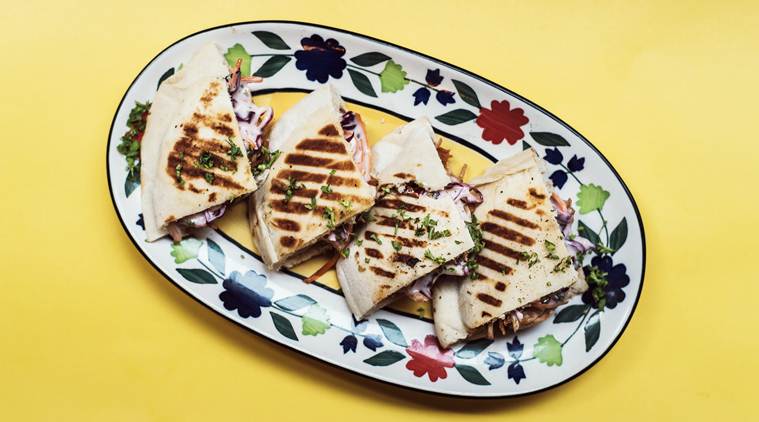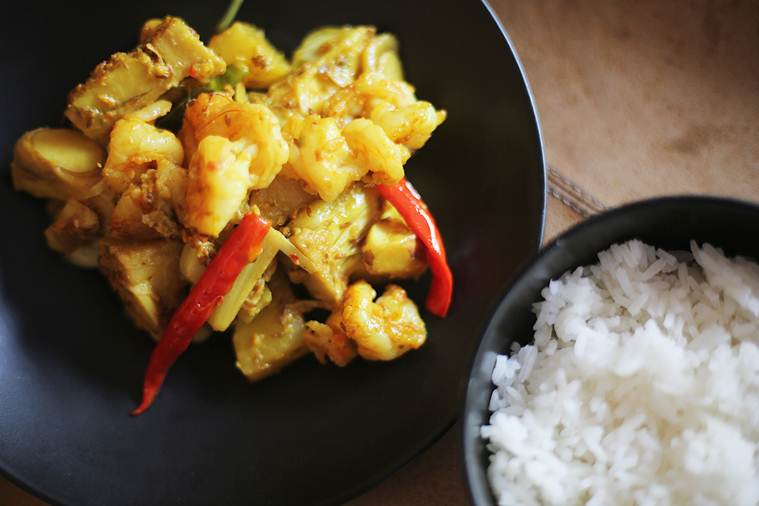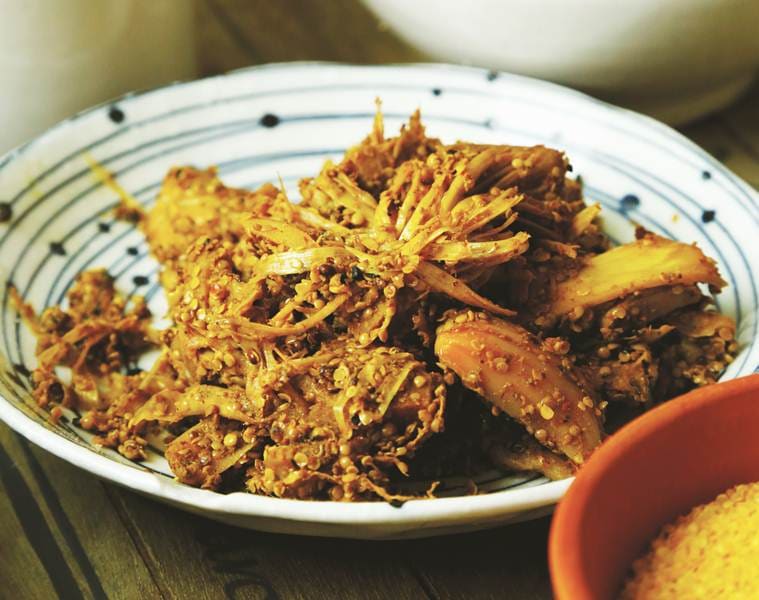 Nature’s bounty: Jackfruit carnitas pita triangle at GreenR cafe in Delhi. (Source: Rishabh Malik)
Nature’s bounty: Jackfruit carnitas pita triangle at GreenR cafe in Delhi. (Source: Rishabh Malik)
For those who have spent the warmest months of the year along the Malabar coast, the distinctive whiff of ripened jackfruit is bundled up safely in memory. Its green, jagged exterior belies the treasures it holds. A pair of hands and a knife slathered with oil as defence against the sticky sap it bleeds and a little bit of skill can take you to the riches. In its ripened form, it reveals its bright, golden flesh, soft and succulent; when immature, it mingles easily with spices and transforms into delicacies devoured through summer up to Onam.
In a country obsessed with mangoes, the fruit has not yet got its due. It is rarely relished when ripe in north India. In Kerala, its ubiquity ensures that it dominates the summer fare. Unsurprisingly then, it was recently declared the state fruit of Kerala.
The move is aimed at boosting the state’s rural economy and encouraging food and financial security for small-scale farmers. “It has always been considered a minor fruit but it holds great significance in Kerala,” says CD Suneesh, founder trustee, Uravu Indigenous Science and Technology Study Centre, Wayanad, that has organised the Chakka Mahotsavam (jackfruit festival) in Thiruvananthapuram every year since 2006.
India grows more than 14 lakh tonnes of jackfruit every year, 70 per cent of which is not consumed. A highly nutritious fruit, it is recommended to diabetics and those with high cholestrol levels. It is also said to lower the risk of heart disease. “We conceived the festival to highlight the usefulness of the fruit and to prevent its wastage. After 12 years, our efforts and those of other campaigns have galvanised the government into action,” he says.
Grown widely in homesteads and found in the wild in Kerala, jackfruit or chakka is eaten both ripe and raw. Most commonly, it is steamed and mashed when tender and garnished with coconut to make thoran. In a chakka erissery, the curry, laced with coarsely ground coconut, is tempered with coconut oil, mustard seeds, curry leaves, dry red chillies and garnished with more coconut. Another standard preparation is puzhukku that combines garlic, green chillies, coconut and cumin with chakka and is offered as a replacement for rice.
“Though chakka, in some form or the other, would find a place on everyone’s table, my favourite was the chakka chips my grandmother would fry for us,” says Prima Kurien, a Delhi-based caterer and author, as she recalls her return from boarding school to her grandparents’ in Kottayam. “It is a community activity for the women of Kerala. Some would peel the jackfruit, while others would cut it into thin slices and another person would fry the chips,” she adds. Homecoming, for Kurien, even today is the smell of chakka hitting the seething coconut oil.
When it was time to go back to school in Ooty, tins of chakka chips were packed for the children of the Kurien house. “I would use them as currency to get what other kids had brought from their homes,” she says with a laugh. She emphasises the use of every part of the fruit, “including the seeds which are cooked in a mango curry — another favourite. Even the peels were used to feed the cows.”
But jackfruit isn’t Kerala’s boast alone, with over 100 genotypes found across the country. Chakka is north India’s kathal, Gujarat and Maharashtra’s phanasa, Tamil Nadu’s palappalam, Orissa’s panasa, West Bengal’s enchor and Meghalaya’s tebrong.
 Eat it ripe, eat it raw: Chef Anumitra Ghosh-Dastidar preps up for a family favourite. (Source: Express photo by Tashi Tobgyal)
Eat it ripe, eat it raw: Chef Anumitra Ghosh-Dastidar preps up for a family favourite. (Source: Express photo by Tashi Tobgyal)
The stately jackfruit tree that stood in attention outside historian Rana Safvi’s house during her childhood in Lucknow bent only with the promise of a reward. “We had a Bengali lady who worked at our house and would know when to pluck the fruit. Though we never took to the taste of ripe jackfruit, we often use raw kathal to make sabzi. The fruit, when young, has a very fleshy texture and works beautifully as a substitute for mutton. I often make kebabs, koftas and even a kathal biryani once in a while,” says Safvi.
In neighbouring Bihar, too, “koftas of raw kathal,” says food consultant and author Pallavi Nigam Sahay, “resemble meat so much, they are often fed to children as chicken or mutton.” Sahay’s romance with Bihari cuisine started as a young bride, when she tasted a kathal condiment for the first time — as part of a feast made for the bridegroom’s family.
“Pickling raw kathal, including its seeds, is very popular and done regularly in Bihar’s households. Though it’s made in other parts of the country as well, in our version, the spices and garlic are more pronounced,” she says, adding, “it pairs well with sattu ka parantha and sattu kachori.”
Eastward, in West Bengal, the fruit grows in the northern and southern extremes of the state. Oft referred to as gachh pantha or “goat of the tree”, enchor for Bengali widows “was an alternative to meat, which they were forbidden from eating. A basic enchorer torkari (jackfruit curry) was then made using cumin, green chillies and ginger, and would not even have onion or garlic in it,” says Anumitra Ghosh-Dastidar, sous chef, Diva, who caught the Delhi gourmand’s eye with the now-defunct Bengali-cuisine centric restaurant, The Big Bongg Theory, in CR Park.
Much like their Malayali counterparts, Bengalis eat the fruit when it is ripe. “In some parts of Bengal, especially the north, the jackfruit tree is a ubiquitous sight. The ripened fruit is called kathal and is eaten without cooking and also with milk. A very ripe kathal is made into a paste and then reduced to a jam-like texture. I would eat it with ice-cream or custard as a child,” says Ghosh-Dastidar. Unlike other cuisines, Bengali cuisine doesn’t only use the vegetable as faux meat. “It is often cooked with shrimp or small fish. A complex dish of pumpkin, jackfruit seeds and dry fish is my family’s speciality,” she adds.
The Garo tribe of Meghalaya, too, cooks the seeds of the pendulous fruit with “dry fish or boils them with dal,” says Nambie Marak, a Garo who runs the YouTube channel, Eat Your Kappa, on the tribe’s food. “But it is mostly eaten when ripe and uncooked. Sometimes we dry the seeds under the sun, peel off its sheer skin and eat it as a snack,” she adds. Though she rues the “lack of inventiveness around the fruit in Meghalaya”, it has given her memories for a lifetime. “Cutting jackfruit is quite cumbersome so we made it a family affair. All of us — my parents, my two elder brothers and I — would sit on the floor in a circle with bowls of water by our side to keep our hands from sticking and cut the fruit,” she says.
The recent drift towards veganism has brought jackfruit back to the urban Indian diner’s table. “Before synthesised plant protein came into the picture, jackfruit was the king of vegan cuisine. It’s still used in many dishes,” says Nitin Dixit, co-founder of the vegan cafe, Greenr, in Delhi’s Shahpur Jat. Extensively marketed as vegan pulled pork in the West, “it often replaces meat in popular recipes. At Greenr, we rest it in a brine overnight and then pan sear it the next day. Typically how a pork equivalent would be made. The pulled jackfruit can then be stuffed into tacos or burgers,” he says.
Given the jackfruit’s versatility, its recently acquired designation is certainly well-earned. But for those who have loved the fruit, in a country of mangoes and apples, pear and plums, it is, perhaps, its humility that marks it. So, the next time a jackfruit tree, like the one outside Safvi’s Lucknow home, bends for you, pick one.
RECIPES:
Jackfruit with Shrimps (Chingri machh diye enchor)
Recipe by Anumitra Ghosh-Dastidar
 Jackfruit Shrimp with Rice by Chef Anumitra Ghosh-Dastidar. (Source: Express photo by Tashi Tobgyal)
Jackfruit Shrimp with Rice by Chef Anumitra Ghosh-Dastidar. (Source: Express photo by Tashi Tobgyal)
Ingredients:
500g – Raw jackfruit
100g – Potato, cut into cubes
200g – Small to medium shrimp
50ml – Mustard oil
1/2 tsp – Turmeric
4-6 – Green chilli
3 – Bay leaf
2 – Cardamom
1tsp – Ghee
1/2 tsp – Sugar
Salt to taste
For the Paste:
1 tsp – Cumin
1\2 inch – Fresh turmeric
1\2 inch – Fresh ginger
2 – Green chilli
Method:
* Cut jackfruit into cubes. Boil with turmeric and salt (it should be cooked but firm). Saute the shrimp lightly with salt in 1 tbsp of oil.
* Heat oil, temper it with bay leaf, cardamom and green chilli.
* Add potato. Cook it on low heat for 2-3 minutes.
* Add the paste. Cook it for another 4-5 minutes. Add a little water, let it dry out then add jackfruit. Cook it for some time.
* Add 200ml of warm water. Let it boil, and then add the shrimp. Cook it for a couple of minutes.
* Switch off the gas. Add ghee and cover it for few minutes. Serve hot.
Jackfruit Carnitas Pita Triangle
Ingredients:
1kg – Jackfruit after preparation
3g – Thyme
2g – Garlic
100g – Carrots
75g – White onion
75g – Celery
2g – Bay leaf
5g – Whole peppercorn
100ml – Water
Method:
* Cut raw jackfruit into pieces.
* Add sliced carrots, celery, onions, peppercorn, bayleaf and jackfruit in a tray and season with salt.
* Cover with foil and heat in the oven at 200 degrees Celsius for 15 minutes.
* Remove from the oven and once cooled, shred the jackfruit.
* To prepare the jackfruit, grill on a hot plate or a pan and mix your favourite barbeque or any other dipping sauce.
* Serve the shredded jackfruit mix inside a pita pocket with coleslaw.
* Garnish with fresh cilantro.
Jackfruit Pickle (Kathal ka achaar)
Recipe by Pallavi Nigam Sahay
 Jackfruit Pickle by Pallavi Nigam Sahay. (Source: Shabin E: The Bhojpuri Kitchen, Westland)
Jackfruit Pickle by Pallavi Nigam Sahay. (Source: Shabin E: The Bhojpuri Kitchen, Westland)
Ingredients:
1kg – Jackfruit, peeled and cut into chunks
20g – Salt
500ml – Mustard oil
For the seasoning:
25g – Turmeric powder
100g – Mustard seeds, powdered
30g – Red chilli powder
1tbsp – Nigella seeds
1tsp – Asafoetida powder
60g – Salt
Method:
* Put enough water to cover the jackfruit into a large pan and bring to a boil.
* Add 20g of salt to the jackfruit. Let it come to a boil.
* Remove from heat and drain thoroughly. Set aside to cool completely.
To season:
* Mix the powdered spice and salt in a bowl.
* Add it to the jackfruit and mix with your hands till the jackfruit is evenly coated.
To store:
* Heat the mustard oil in a pan over high heat, till it smokes.
* Remove from heat and let it cool.
* Transfer the jackfruit to an airtight, sterilised jar.
* Pour the cooled oil over the jackfruit and place in the sun for 5-6 days before use.
* Make sure that the jackfruit is completely covered with oil. Add more if required.